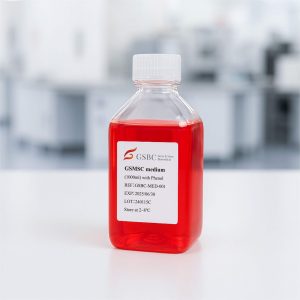Product Details
- Product Name: PriGrow™ I Medium
- Product Type: Medium
- Catalog Number: TM001
- Unit Size: 500 mL
- Formulation: Serum-free and antibiotic-free basal medium
- Appearance: Liquid
- pH Range: 7.15-7.25
- Osmolarity: 270-310 mOsm/kgH₂O
- Endotoxin Level: ≤ 1 EU/mL
- Sterility: Pass
- Storage Condition: 2-8°C
- Shipping Condition: Shipped on ice packs
Overview
PriGrow™ I Medium is a specially formulated basal medium optimized for mammalian cell culture. It is designed to provide a flexible and customizable foundation for researchers, allowing supplementation with specific growth factors, serum, or antibiotics as required. Each batch undergoes rigorous quality control testing to ensure consistent sterility, optimal pH balance, osmolality, and low endotoxin levels.
This medium is ideal for use in a wide range of cell biology applications, including primary cell culture, immortalized cell line expansion, and specialized research in cell signaling and differentiation.
Key Features and Benefits
- Serum-Free and Antibiotic-Free: Provides maximum flexibility for experimental design and downstream applications.
- Optimized for Mammalian Cell Growth: Ensures consistent cell culture performance across multiple applications.
- High Purity and Low Endotoxin Levels: Stringent QC testing guarantees sterility and minimal endotoxin contamination.
- Customizable Composition: Can be supplemented with specific growth factors and sera to meet experimental needs.
- Validated for Reproducibility: Every lot is tested for pH stability, osmolality, and sterility to maintain batch-to-batch consistency.
Key Ingredients and Special Additives
- L-Glutamin: 102.63 mM
- D-Glucose: : 4.77 mM
Quality Control (QC)
Each batch of PriGrow™ I Medium undergoes comprehensive quality control testing to ensure high reliability in mammalian cell culture applications. The QC process includes:
- Cell Culture Performance: Assessment of adherence rate (if applicable), morphology, and metabolic activity of tested cell lines.
- Sterility Testing: Ensures no microbial or fungal contamination.
- Physicochemical Properties: pH balance and osmolality testing.
- Endotoxin Screening: Guarantees an endotoxin-free environment to support sensitive cell cultures.
Caution
For research use only. Not intended for therapeutic, diagnostic, or clinical applications. This product is strictly for laboratory research purposes and should not be used in human subjects.
Disclaimer
- This product is intended exclusively for laboratory research and is not approved for human or medical applications.
- The manufacturer makes no warranties regarding the accuracy, completeness, or suitability of this product beyond its intended research use.
- Any referenced literature or third-party citations are provided for informational purposes only and do not imply validation or endorsement of specific results.
References
- Gong, Bin, et al. “Exchange protein directly activated by cAMP plays a critical role in bacterial invasion during fatal rickettsioses.” Proceedings of the National Academy of Sciences 110.48 (2013): 19615-19620.
- Gong, Bin, et al. “Compartmentalized, functional role of angiogenin during spotted fever group rickettsia-induced endothelial barrier dysfunction: evidence of possible mediation by host tRNA-derived small noncoding RNAs.” BMC infectious diseases 13 (2013): 1-16.
- Gong, Bin, et al. “Rickettsiae induce microvascular hyperpermeability via phosphorylation of VE-cadherins: evidence from atomic force microscopy and biochemical studies.” PLoS neglected tropical diseases 6.6 (2012): e1699.
- Gong, Bin, et al. “Methods of treating rickettsia using exchange proteins directly activated by camp (epacs) inhibitors.” U.S. Patent Application No. 14/455,325.
- Hansen, Kellisa, et al. “Feasibility investigation of cellulose polymers for mucoadhesive nasal drug delivery applications.” Molecular pharmaceutics 12.8 (2015): 2732-2741.
- Jeyabal, Prince, et al. “MicroRNA-9 inhibits hyperglycemia-induced pyroptosis in human ventricular cardiomyocytes by targeting ELAVL1.” Biochemical and biophysical research communications 471.4 (2016): 423-429.
- Lai, I-Lu, et al. “RETRACTED: Targeting the Warburg effect with a novel glucose transporter inhibitor to overcome gemcitabine resistance in pancreatic cancer cells.” Carcinogenesis 35.10 (2014): 2203-2213.
- Jeyabal, Prince, et al. “MicroRNA-9 inhibits hyperglycemia-induced pyroptosis in human ventricular cardiomyocytes by targeting ELAVL1.” Biochemical and biophysical research communications 471.4 (2016): 423-429.
- Li, Yan, et al. “Oncolytic Ad co-expressing decorin and Wnt decoy receptor overcomes chemoresistance of desmoplastic tumor through degradation of ECM and inhibition of EMT.” Cancer letters 459 (2019): 15-29.
- Liu, Qi, et al. “Use of polymeric nanoparticle platform targeting the liver to induce treg-mediated antigen-specific immune tolerance in a pulmonary allergen sensitization model.” ACS nano 13.4 (2019): 4778-4794.
- Liu, Qiong, et al. “The role of R-spondin 1 through activating Wnt/β-catenin in the growth, survival and migration of ovarian cancer cells.” Gene 689 (2019): 124-130.
- Quintela, Marcos, et al. “HBO1 directs histone H4 specific acetylation, potentiating mechano-transduction pathways and membrane elasticity in ovarian cancer cells.” Nanomedicine: Nanotechnology, Biology and Medicine 17 (2019): 254-265.



